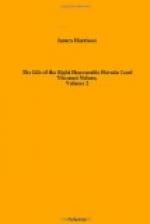victory, he said to Captain Hardy, and the other officers
by whom he was surrounded—“They cannot
now escape us! I think, we shall, at least, make
sure of twenty of them. I may, probably, lose
a leg; but that will be cheaply purchasing a victory.”
However, it is an undoubted fact, that when the Honourable
Captain Blackwood, in taking leave of his lordship,
previous to the action, observed that, he hoped they
should, in a few hours, meet again; the hero replied,
in a firm tone—“My dear Blackwood,
I shall never again speak to you!” This was
no sentiment of despondency, but a strong sense of
the danger to be apprehended from so unequal a contest.
The enemy’s line consisting of thirty-three
ships, eighteen of which were French, and fifteen
Spanish; and the British fleet only twenty-seven:
and, by the advantage of size, as well as numbers,
they had a superiority of about three hundred and
fifty guns. Ten thousand of their choicest troops
were also distributed throughout the fleet, to ensure
success by boarding; and their ships were furnished
with fire-balls and combustibles of every description,
in the hope of setting our’s on fire. The
French were commanded, in chief, by Admiral Villeneuve;
and not by Admiral Decrees, as Lord Nelson had lately
supposed would be the case; with Rear-Admirals Dumanoir
and Magon: The Spaniards, by Admiral Gravina,
commander in chief; with Admirals Don Ignacio Morea
D’Alva, Don Domingo Guadalharas, and Commodore
Don Baltazar. The structure of the enemy’s
line was somewhat new, as well as the intended mode
of attacking them. It formed a crescent, convexing
to leeward: every alternate ship being about
a cable’s length to windward of it’s second
a-head and a-stern, so as to seem a kind of double-line;
leaving between them, when on their beam, a very small
interval, and this without crouding their ships.
Admiral Villeneuve, in the Bucentaure, occupied the
centre; and Admiral Gravina’s flag was borne
by the Prince of Asturias, in the rear: but the
French and Spanish ships appear to have been mixed,
without any regard to national arrangement.
The mode of attack having been long determined on
by Lord Nelson, and recently communicated, as has
been seen, on the 10th instant, to the flag officers
and captains, few signals were necessary. On first
discovering the combined fleet, his lordship had immediately
made the signal to bear up in two columns, as formed
in the order of sailing, to avoid the inconvenience
and delay of forming a line of battle in the usual
manner. Lord Nelson, as commander in chief, led
the weather column, in the Victory; and Vice-Admiral
Collingwood, as second in command, that of the lee,
in the Royal Sovereign. The following are the
respective ships of which the two British lines were
composed—
BRITISH VAN, OR WEATHER
COLUMN.
Ships. Guns.
Commanders.




